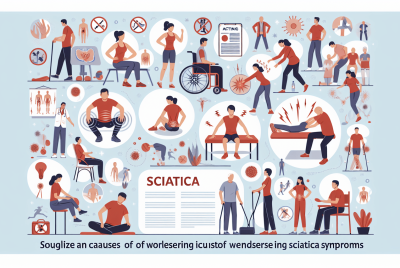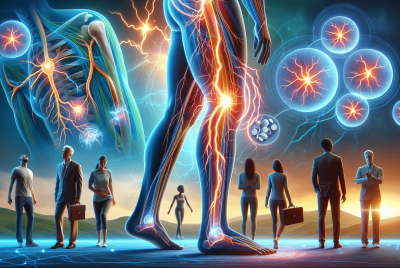How To Relieve Back Pain Naturally
Back pain can be a debilitating experience that affects your daily life. Whether it’s caused by stress, poor posture, or a sedentary lifestyle, finding natural ways to alleviate the discomfort is crucial. In this article, you will discover simple yet effective techniques to relieve back pain without the need for medication or invasive procedures. With these natural remedies, you can reclaim control over your body and experience the relief you deserve.
Ways To Relieve Back Pain Naturally
1. Exercise and Stretching
Build Core Strength
Building core strength is crucial for supporting the spine and relieving back pain. Core exercises such as planks, crunches, and bridges can help strengthen the muscles in the abdomen, back, and pelvis. A strong core helps to improve posture, stability, and reduces stress on the spine.
Practice Yoga or Pilates
Yoga and Pilates are both excellent forms of exercise that can help alleviate back pain. These practices focus on stretching, flexibility, and strengthening the muscles of the core and back. Yoga poses such as Cat-Cow, Child’s Pose, and Downward Dog can help improve spinal flexibility and reduce tension in the back.
Try Low-Impact Aerobic Exercises
Engaging in low-impact aerobic exercises like swimming, walking, or biking can provide numerous benefits for your back. These activities help increase blood flow, strengthen muscles, and promote overall fitness without putting excessive strain on the spine. Additionally, aerobic exercises release endorphins, which are natural pain relievers.
Engage in Regular Stretching
Regular stretching is essential for maintaining flexibility and reducing back pain. Gentle stretching exercises like hamstring stretches, calf stretches, and hip stretches can help alleviate muscle tension and improve range of motion. Stretching should be done daily and before and after physical activity.
Incorporate Back Strengthening Exercises
Strengthening the muscles in your back can help support your spine and reduce the risk of back pain. Exercises such as back extensions, supermans, and rows can target the muscles in the back, promoting better posture and reducing the strain on the spine. It is important to perform these exercises with proper form and technique to avoid injury.
2. Maintain Good Posture
Sit and Stand Tall
Maintaining good posture is essential for preventing and relieving back pain. When sitting, make sure to sit up straight with your shoulders back and aligned with your hips. When standing, distribute your weight evenly on both feet and avoid slouching. Remember to engage your core muscles to support your spine.
Use Supportive Chairs and Mattresses
Investing in supportive chairs and mattresses is crucial for maintaining good posture and reducing back pain. Choose chairs that provide lumbar support and have adjustable height and backrests. Similarly, opt for mattresses with medium firmness that offer adequate support for your spine. Avoid sleeping on excessively soft or sagging mattresses.
Avoid Slouching
Slouching is a common habit that can contribute to back pain. Be mindful of your posture throughout the day and avoid slumping or rounding your shoulders. Regularly check in with your body, and if you catch yourself slouching, readjust your position to sit or stand tall. Maintaining proper alignment will reduce strain on your back.
Adjust Computer and Desk Setup
Proper ergonomics at your workspace can significantly improve your posture and reduce back pain. Ensure that your computer monitor is at eye level, and your keyboard and mouse are positioned at a comfortable height. Use a chair that supports your lower back, and adjust the height of your desk to promote proper alignment of your spine.
Use Proper Lifting Techniques
Improper lifting techniques can put significant strain on your back, leading to pain and injury. When lifting heavy objects, remember to bend at your knees and hips, not your waist. Keep the object close to your body and avoid twisting while lifting. Engage your core muscles and lift with your legs to minimize strain on your back.

3. Apply Heat and Cold Therapy
Use Heating Pads
Applying heat to the affected area can help relax muscles, increase blood flow, and provide relief from back pain. Use a heating pad or a hot water bottle wrapped in a towel and apply it to the painful area for 15-20 minutes. Heat therapy can be especially beneficial for muscle spasms and chronic back pain.
Apply Hot or Cold Compresses
Both hot and cold compresses can be effective in reducing back pain. Cold compresses help to numb the area and reduce inflammation, while heat compresses can relax muscles and improve circulation. Alternate between hot and cold therapy by applying a cold compress for 20 minutes, followed by a warm compress for 20 minutes, several times a day.
Take Warm Baths or Showers
Enjoying a warm bath or shower can provide soothing relief for back pain. The warm water helps relax muscles and promote blood flow to the affected area. Allow the water to massage your back, and if possible, add Epsom salts to the bathwater for added muscle relaxation benefits.
Try Contrast Therapy
Contrast therapy involves alternating between hot and cold treatments and can be particularly effective for relieving back pain. Begin with hot therapy for 3-4 minutes, followed by cold therapy for 1-2 minutes. Repeat this cycle for 20-30 minutes. The contrast in temperatures helps reduce inflammation, release muscle tension, and improve circulation.
Use Hot or Cold Topical Creams
Topical creams containing menthol, capsaicin, or other analgesic ingredients can provide temporary relief from back pain. Hot creams create a warming sensation and improve blood flow, while cold creams create a cooling sensation and numb the area. Apply the cream to the affected area and massage it gently for maximum effect.
4. Practice Mindful Meditation and Relaxation
Deep Breathing Exercises
Deep breathing exercises can help reduce stress, relax the body, and alleviate back pain. Practice diaphragmatic breathing by inhaling deeply through your nose, allowing your belly to rise, and exhaling slowly through your mouth. Deep breathing stimulates the body’s natural relaxation response and helps you connect with your body.
Meditation Techniques
Meditation is a powerful tool for managing back pain by promoting relaxation and reducing stress. Find a quiet and comfortable space, close your eyes, and focus on your breath or a specific mantra. Allow your thoughts to come and go without judgment, creating a sense of calm and peace within your mind and body.
Progressive Muscle Relaxation
Progressive muscle relaxation involves tensing and then releasing each muscle group in your body, promoting deep relaxation and reducing muscle tension. Start at your feet and work your way up, contracting each muscle group for a few seconds before releasing. This technique helps bring awareness to areas of tension and allows you to consciously relax those muscles.
Guided Imagery and Visualization
Guided imagery and visualization can be a powerful tool for pain management. Close your eyes and imagine yourself in a peaceful and serene environment. Visualize the tension melting away from your back and imagine your muscles becoming loose and relaxed. Allow yourself to fully immerse in this positive mental imagery, promoting both physical and mental relaxation.
Yoga Nidra or Sleep Meditation
Yoga Nidra, also known as sleep meditation, is a deeply relaxing practice that can promote pain relief and restful sleep. Lie down in a comfortable position and follow a guided meditation that leads you through various stages of relaxation. Yoga Nidra helps calm the nervous system, reduce stress, and alleviate back pain by inducing a state of deep relaxation.

5. Maintain a Healthy Weight
Eat a Balanced Diet
Maintaining a healthy weight through a balanced diet is essential for back pain management. Include plenty of fruits, vegetables, whole grains, lean proteins, and healthy fats in your meals. A well-balanced diet provides the necessary nutrients to support overall spine health and reduce inflammation in the body.
Control Portion Sizes
Portion control plays a vital role in managing your weight and preventing excess pressure on your back. Be mindful of portion sizes and avoid overeating. Listen to your body’s hunger and fullness cues, and aim to eat smaller, more frequent meals throughout the day to keep your energy levels stable.
Stay Hydrated
Proper hydration is essential for maintaining spinal health and reducing back pain. Drink an adequate amount of water throughout the day to keep your discs hydrated and maintain optimal functioning. Dehydration can lead to the degeneration of spinal discs, causing increased back pain and stiffness.
Avoid Excess Sugar and Processed Foods
High sugar and processed foods can promote inflammation in the body, exacerbating back pain. Limit your consumption of sugary snacks, desserts, and processed snacks. Instead, choose whole, unprocessed foods that are rich in nutrients and antioxidants, which can help reduce inflammation and support a healthy back.
Incorporate Anti-inflammatory Foods
Adding anti-inflammatory foods to your diet can help alleviate back pain. Include foods such as fatty fish (salmon, tuna), turmeric, ginger, cherries, berries, leafy greens, nuts, and olive oil. These foods contain compounds that have anti-inflammatory properties and can help reduce pain and inflammation in the body.
6. Practice Good Sleep Habits
Ensure Proper Mattress and Pillow Support
Investing in a supportive mattress and pillow is essential for maintaining proper spinal alignment while you sleep. Choose a mattress that provides adequate support and matches your preferred sleep position. Similarly, select a pillow that keeps your neck in a neutral position, aligning it with your spine.
Sleep in a Comfortable Position
Sleeping in a comfortable position can alleviate back pain and ensure a restful night’s sleep. If you sleep on your back, try placing a pillow under your knees to reduce stress on your lower back. If you prefer to sleep on your side, bend your knees slightly and place a pillow between them for optimal spinal alignment.
Establish a Regular Sleep Schedule
Establishing a regular sleep schedule is vital for maintaining a healthy back. Aim for 7-8 hours of sleep each night and try to go to bed and wake up at the same time every day. Consistency in your sleep patterns helps optimize your body’s circadian rhythm and promotes restorative sleep.
Create a Relaxing Bedtime Routine
Creating a relaxing bedtime routine can signal to your body that it’s time to unwind and prepare for sleep. Engage in activities such as reading, taking a warm bath, practicing gentle stretching, or listening to calming music. Avoid stimulating activities and bright screens before bed, as they can interfere with your ability to fall asleep.
Avoid Electronic Devices Before Bed
The blue light emitted by electronic devices can disrupt your sleep-wake cycle and negatively impact the quality of your sleep. Avoid using electronic devices such as smartphones, tablets, and laptops for at least one hour before bed. Instead, engage in relaxing activities that promote a calm and peaceful state of mind.
7. Use Supportive Devices and Braces
Wear a Lumbar Support Brace
A lumbar support brace can provide additional support to the lower back and help alleviate back pain. These braces are designed to stabilize the spine, improve posture, and reduce strain on the muscles and ligaments. However, it is important to use the brace as directed and avoid becoming reliant on it for extended periods.
Use Ergonomic Office Equipment
Using ergonomic office equipment can significantly improve your posture and minimize back pain. Invest in an adjustable chair that offers lumbar support and promotes proper spinal alignment. Additionally, use a keyboard and mouse that are positioned at a comfortable height to avoid strain on your wrists, arms, and upper back.
Use Orthopedic Pillows or Cushions
Orthopedic pillows or cushions can provide additional support and promote better spinal alignment while sitting or sleeping. Use a lumbar roll or cushion to support the natural curve of your lower back when sitting. When sleeping, consider using a contour pillow that cradles your head and neck, maintaining proper alignment with your spine.
Try Posture Correctors or Straps
Posture correctors or straps can help train your body to adopt a more upright posture, reducing stress on the back. These devices remind you to keep your shoulders back and align your spine properly. However, they should be used under the guidance of a healthcare professional and not for extended periods to avoid muscle weakness.
Use Supportive Shoe Insoles
Supportive shoe insoles can help improve your posture and provide relief from back pain. Look for insoles with arch support and cushioning to absorb shock and reduce strain on your back while walking or standing. These inserts can help distribute your body weight evenly and promote proper alignment of your feet and spine.
8. Try Natural Supplements and Herbs
Turmeric
Turmeric is a powerful anti-inflammatory spice that can help alleviate back pain. It contains a compound called curcumin, which has been shown to reduce inflammation and provide pain relief. Consider adding turmeric to your meals or taking a curcumin supplement after consulting with a healthcare professional.
Ginger
Ginger is another natural remedy that possesses anti-inflammatory properties and can help alleviate back pain. It can be consumed in various forms, including ginger tea, capsules, or grated into meals. Ginger can also help reduce muscle soreness and improve mobility.
Devil’s Claw
Devil’s Claw is an herb traditionally used to relieve back pain and reduce inflammation. It contains compounds that have analgesic and anti-inflammatory properties. Devil’s Claw can be taken in the form of capsules or brewed into a tea. It is important to consult with a healthcare professional before using this herb, especially if you have any underlying medical conditions.
Boswellia
Boswellia, also known as Indian frankincense, is a natural resin that has been used for centuries to alleviate joint and back pain. It contains boswellic acids, which have anti-inflammatory effects. Boswellia can be taken as a supplement or used topically in the form of creams or oils.
Magnesium
Magnesium is an essential mineral that plays a crucial role in muscle relaxation and overall health. It can help relax tense muscles, reduce inflammation, and alleviate back pain. Consuming magnesium-rich foods or taking magnesium supplements can be beneficial. However, it is advisable to consult with a healthcare professional before starting any new supplements.
9. Seek Alternative Therapies
Acupuncture
Acupuncture is an ancient Chinese therapy that involves inserting thin needles into specific points on the body to promote natural healing and pain relief. It can help stimulate the release of endorphins, reduce inflammation, and regulate the flow of energy (Qi) in the body. Acupuncture is generally considered safe when performed by a trained and licensed practitioner.
Chiropractic Care
Chiropractic care focuses on addressing issues related to the spine and nervous system through manual adjustments and manipulations. Chiropractors can help correct misalignments (subluxations) in the spine, relieve pressure on nerves, and improve overall spinal function. Chiropractic care can provide relief for back pain and promote optimal spinal health.
Massage Therapy
Massage therapy can help relax muscles, improve blood circulation, and reduce back pain. Different massage techniques such as Swedish massage, deep tissue massage, and trigger point therapy can target specific areas of tension or provide full-body relaxation. Regular massage sessions can help manage chronic back pain and promote overall well-being.
Physical Therapy
Physical therapy involves specialized exercises, stretches, and techniques designed to reduce pain, improve mobility, and strengthen the muscles. A physical therapist can develop a personalized treatment plan tailored to your specific back pain needs. Physical therapy may include exercises, manual therapy, electrical stimulation, heat or cold therapy, and education about posture and body mechanics.
Inversion Therapy
Inversion therapy involves hanging upside down or at an inverted angle to relieve pressure on the spine and reduce back pain. It can help decompress the spine, improve spinal alignment, and increase space between the vertebrae. Inversion therapy can be done using inversion tables, gravity boots, or yoga swings. However, it is important to consult with a healthcare professional before attempting inversion therapy, especially if you have any existing medical conditions.
10. Practice Stress Management
Identify and Manage Stressors
Identifying and managing stressors is crucial for overall well-being and back pain relief. Take time to reflect on the different aspects of your life that may contribute to stress, such as work, relationships, or financial concerns. Once you identify these stressors, develop strategies to manage them effectively, such as setting boundaries, practicing time management, or seeking support.
Engage in Relaxing Activities
Engaging in relaxing activities can help reduce stress levels and alleviate back pain. Find activities that bring you joy and relaxation, such as reading, listening to music, practicing hobbies, or spending time in nature. Regularly incorporating these activities into your routine can provide an outlet for stress and promote physical and mental well-being.
Practice Time Management
Proper time management can help reduce stress and prevent feelings of overwhelm that can contribute to back pain. Prioritize tasks, create a schedule, and set realistic goals to ensure a balanced and manageable workload. Avoid procrastination and break larger tasks into smaller, more manageable steps to reduce stress levels.
Get Sufficient Rest and Breaks
Getting sufficient rest and taking regular breaks throughout the day is essential for managing stress and preventing back pain. Listen to your body’s signals and make sure to give yourself time to recharge. Take short breaks during work or other activities to stretch, relax, or practice deep breathing exercises. This will help alleviate muscle tension and promote a sense of calm.
Seek Support and Counseling
When experiencing chronic back pain, seeking support from family, friends, or a professional counselor can be beneficial. Talking about your feelings and concerns can help reduce stress and provide emotional support. Counseling can also provide tools and techniques for managing stress and coping with the challenges of living with chronic back pain.
By incorporating these natural and holistic approaches into your daily routine, you can alleviate back pain, improve your overall well-being, and promote a healthy spine. Remember to consult with a healthcare professional before making any significant changes to your exercise, diet, or lifestyle, especially if you have any underlying medical conditions or concerns. Take a proactive approach to your back health and embrace these natural methods to find relief from back pain.




